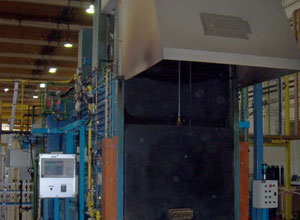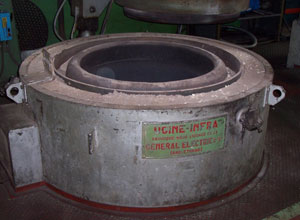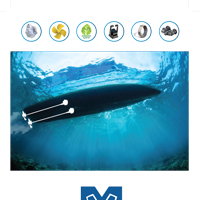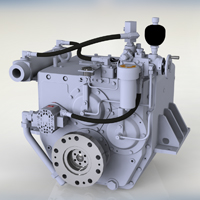An essential operation to ensure the desired properties
Heat treatment implies heating, and then cooling the material in accordance with particular curves, and under precisely defined atmospheres, to yield the desired properties.
For quality inssurance reasons, the heat treatment is closely monitored by our QC department, by means of certain specific devices (cf. chapter “quality”); for each furnace batch, a graph is recorded, and a specimen blank is used for control purposes.
The following materials are heat-treated in that way:
- 42CrMoS4 grade steel (quenching and stabilisation)
- EN – GJL 250 cast iron (stabilisation)
- 17CrNiMo6 grade steel (quenching and carburization)
3 types of heat treatment are being used at Masson-Marine’s:
- Oil bath hardening: The parts are held at 850 °C during 4h38; then they are held at tempering level for 3 hours. The annealing temperature is a function of the material being tempered, and the desired hardness.
- Carburizing: It consists in providing, at the surface of the part, a layer with a high carbon content, so as to increase the hardness of the teeth. The depth of this recarburization varies with the module of the gear teeth. For a module 2.5, carburization would be 0.7 to 0.8 mm deep; for a module 8, the depth would be 1.6 to 1.7 mm. Cycle time (annealing not included) is between 7 h (module 2.5) and 19 h (module 8). The temperature range is 925 °C. Annealing is performed at 190 °C for 5 h; cooling down to room temperature follows at the open air.
- Stabilisation (annealing): The furnace heats up to 580 °C for 3 h, then it is left to drop to 350 °C. This threshold reached, the furnace door opens to let the parts cool down to ambient.
Masson-Marine use two types of furnaces:
1 CIEFFE LLF 13 EXR
This furnace is used for the quenching and carburizing operations.
- It has a capacity of 1,500 kg, is 910 mm wide, 1,150 mm high, and 1,520 mm deep.
- Heat is supplied through 12 heating coils with a combined power of 200 kW.
- Quenching provides a degree of hardness of 100 to 110 kg on 42CD4 grade steel, and 70-80 kg on 18NCD6 grade steel.
- Carburizing 18NCD6 grade steel produces a hardness of 58 to 60 HRC, i.e. 200 to 210 kg.

3 UGINE furnaces
- 1 furnace is used for the annealing process after carburization.
- 2 furnaces are used for the tempering treatment after quenching.

Quick Menu
New Offers & New
Products
-
New Brochure 2024
 Download!
Download! -
Partnership : Become one of our agents!
 Let’s work together to reinforce and develop an effective network. Sign Up Now!
Let’s work together to reinforce and develop an effective network. Sign Up Now! -
Interactive Map : Our network at your service!
 Need new equipment or spare parts? Our interactive map is now on line. Find all of our agents with one click only!
Need new equipment or spare parts? Our interactive map is now on line. Find all of our agents with one click only! -
New Aluminium Gearbox 2024
 We are currently finalizing our new aluminium gearbox : ALW550 with ratio 1.326 to 3.000 designed for high rpm engines and light ships. Ask us for more details.
We are currently finalizing our new aluminium gearbox : ALW550 with ratio 1.326 to 3.000 designed for high rpm engines and light ships. Ask us for more details.







